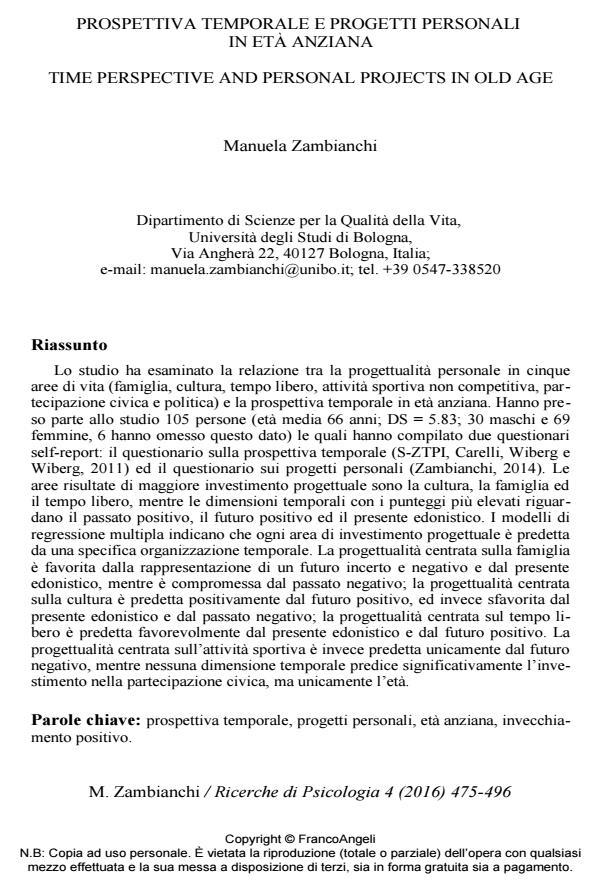Prospettiva temporale e progetti personali in eta anziana
Titolo Rivista RICERCHE DI PSICOLOGIA
Autori/Curatori Manuela Zambianchi
Anno di pubblicazione 2017 Fascicolo 2016/4
Lingua Italiano Numero pagine 22 P. 475-496 Dimensione file 240 KB
DOI 10.3280/RIP2016-004002
Il DOI è il codice a barre della proprietà intellettuale: per saperne di più
clicca qui
Qui sotto puoi vedere in anteprima la prima pagina di questo articolo.
Se questo articolo ti interessa, lo puoi acquistare (e scaricare in formato pdf) seguendo le facili indicazioni per acquistare il download credit. Acquista Download Credits per scaricare questo Articolo in formato PDF

FrancoAngeli è membro della Publishers International Linking Association, Inc (PILA)associazione indipendente e non profit per facilitare (attraverso i servizi tecnologici implementati da CrossRef.org) l’accesso degli studiosi ai contenuti digitali nelle pubblicazioni professionali e scientifiche
Lo studio ha esaminato la relazione tra la progettualità personale in cinque aree di vita (famiglia, cultura, tempo libero, attività sportiva non competitiva, partecipazione civica e politica) e la prospettiva temporale in età anziana. Hanno preso parte allo studio 105 persone (età media 66 anni; DS = 5.83; 30 maschi e 69 femmine, 6 hanno omesso questo dato) le quali hanno compilato due questionari self-report: il questionario sulla prospettiva temporale (S-ZTPI, Carelli, Wiberg e Wiberg, 2011) ed il questionario sui progetti personali (Zambianchi, 2014). Le aree risultate di maggiore investimento progettuale sono la cultura, la famiglia ed il tempo libero, mentre le dimensioni temporali con i punteggi più elevati riguardano il passato positivo, il futuro positivo ed il presente edonistico. I modelli di regressione multipla indicano che ogni area di investimento progettuale è predetta da una specifica organizzazione temporale. La progettualità centrata sulla famiglia è favorita dalla rappresentazione di un futuro incerto e negativo e dal presente edonistico, mentre è compromessa dal passato negativo; la progettualità centrata sulla cultura è predetta positivamente dal futuro positivo, ed invece sfavorita dal presente edonistico e dal passato negativo; la progettualità centrata sul tempo libero è predetta favorevolmente dal presente edonistico e dal futuro positivo. La progettualità centrata sull’attività sportiva è invece predetta unicamente dal futuro negativo, mentre nessuna dimensione temporale predice significativamente l’investimento nella partecipazione civica, ma unicamente l’età.
Parole chiave:Prospettiva temporale, progetti personali, età anziana, invecchiamento positivo
Manuela Zambianchi, Prospettiva temporale e progetti personali in eta anziana in "RICERCHE DI PSICOLOGIA " 4/2016, pp 475-496, DOI: 10.3280/RIP2016-004002